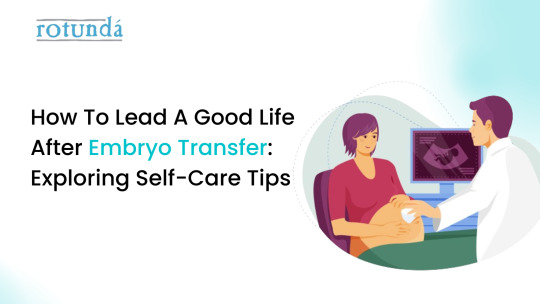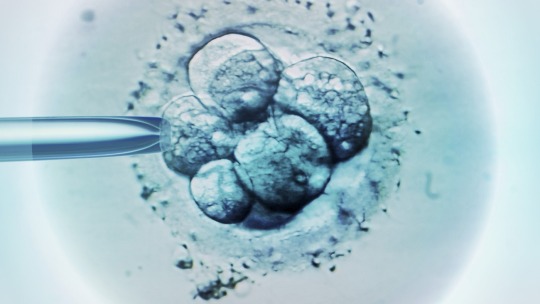#Embryo Transfer
Text
What is IVF?
In recent decades, advancements in medical science have revolutionized the field of reproductive medicine, providing hope and opportunities for couples struggling with infertility. One such groundbreaking technique is In Vitro Fertilization (IVF). In this blog post, we will delve into the intricacies of IVF treatment, exploring what it is, how it works, and the potential it holds for those seeking to build a family.
What is IVF?
In Vitro Fertilization, commonly known as IVF, is a fertility treatment that involves the fertilization of an egg with sperm outside the human body. The process begins by extracting eggs from a woman's ovaries and fertilizing them with sperm in a laboratory dish. Once fertilization occurs, the resulting embryos are then implanted in the woman's uterus with the hope of establishing a successful pregnancy.
Understanding the IVF Process
Ovulation Induction: The first step in IVF involves stimulating the ovaries to produce multiple eggs. Fertility medications are administered to enhance egg production, monitored through ultrasound and blood tests.
Egg Retrieval: Once the eggs are mature, a minor surgical procedure known as egg retrieval is performed. A thin needle is inserted through the vaginal wall to collect the eggs from the ovaries.
Fertilization: The collected eggs are then combined with sperm in a controlled environment, allowing fertilization to occur. This step is closely monitored to ensure the formation of healthy embryos.
Embryo Culture: The fertilized eggs, now embryos, are cultured and monitored for several days. The healthcare team assesses their quality before selecting the most viable embryos for transfer.
Embryo Transfer: In the final step, one or more selected embryos are transferred into the woman's uterus. This is a relatively simple and painless procedure that aims to establish a successful pregnancy.
Success Rates and Considerations
IVF success rates vary depending on several factors, including the age of the woman, the cause of infertility, and the quality of the embryos. While some individuals achieve pregnancy in the first cycle, others may require multiple attempts. It's essential to approach IVF with realistic expectations and to consult with healthcare professionals to understand individual circumstances.
Challenges and Emotional Aspects
Embarking on an IVF journey can be emotionally challenging for couples. The process involves physical, emotional, and financial commitments, and individuals may experience a range of emotions, from hope and excitement to disappointment and stress. Support from loved ones and mental health professionals can play a crucial role in helping individuals navigate these challenges.
Conclusion
In Vitro Fertilization has emerged as a beacon of hope for many couples facing infertility challenges.
Schedule a Consultation with Dr. Sonal Lathi Today If you are considering IVF treatment, Dr. Sonal Lathi is the perfect choice for you. She is a leading expert in IVF, and she is committed to helping couples achieve their parenthood dreams.
#IVF#fertility treatment#reproductive health#in vitro fertilization#family building#infertility#assisted reproductive technology#egg retrieval#embryo transfer#pregnancy journey#parenting hope#medical advancements#healthcare#women's health#parenthood#emotional wellness#support network#family building options#fertility awareness#IVF success#embryo quality#hopeful beginnings#modern medicine#couples' journey#future of reproductive medicine#life through IVF
2 notes
·
View notes
Text
Two years of trying to conceive naturally & two rounds of unsuccessful IUIs.
Insert IVF Process:
SHOTS ✅
Endless Blood Draws ✅
Uncomfortable # of Transvaginal Ultrasounds ✅
Egg Retrieval ✅
We started with 14 eggs. 13 were mature. 8 fertilized.
We officially have 3 beautiful little frozen embryos 💕
✨ Hoping for some baby dust! Waiting to start the embryo transfer process ✨
#infertility#fertility#ivf#ivfjourney#ivf process#ivfsupport#embryo#embryology#pcos symptoms#pcos women#pcosinfertility#pcossupport#ttc with pcos#ttc over 25#ttc with infertility#ttccommunity#ttcsupport#embryo transfer#frozen embryo
9 notes
·
View notes
Text
How many days after egg retrieval is embryo transfer?

Egg retrieval went smoothly, and now you're in the exciting (and maybe a little anxious) two-week wait after embryo transfer! Wondering what "positive signs" might look like? Let's understand:
Remember: Everybody is different, and there's no one-size-fits-all list of pregnancy symptoms after embryo transfer. Some women might experience a few early signs, while others won't feel anything at all until a positive pregnancy test.
But wait, there are a few things to keep in mind:
Implantation Dip: A dip in body temperature around 6–10 days after transfer can sometimes occur during implantation when the embryo burrows into the uterine lining.
Mood Swings and Cramping: Similar to early pregnancy symptoms, some women experience mild cramping, bloating, or mood swings after transfer. But these can also be caused by hormonal imbalances from the medications used during IVF.
Here's the Golden Rule: Don't overanalyze every twinge or feeling. The two-week wait is a marathon, not a sprint. Focus on staying positive and healthy!
Positive signs after transfer often come in the form of a positive pregnancy test around 10–12 days after transfer. That's the real gold standard!
Top Tip: Resist the urge to take a test too early. Home pregnancy tests might not be accurate before implantation has occurred.
Remember, patience is key! Stay positive, listen to your body, and celebrate small victories. And of course, follow your doctor's instructions for post-transfer care. Here's to a successful transfer and a happy journey ahead!
#positive signs after embryo transfer#sex night before embryo transfer#embryo transfer#after embryo transfer day by day symptoms
0 notes
Text
How To Lead A Good Life After Embryo Transfer: Exploring Self-Care Tips

The IVF cycle succeeds only if the embryo transfer is optimal since it is the most crucial part of the treatment. A good embryo implantation decides the fate of your pregnancy. Thus, your health should be the top priority for the next few weeks after embryo transfer. Ensure that you care for yourself by following some useful tips.
0 notes
Text
youtube
Blastocyst Culture & Embryo Transfer: In-depth Analysis at Indira IVF
Blastocyst culture & transfer: Discover the process of frozen blastocyst transfer, embryo implantation, and Learn the importance of implanted blastocyst transfer. Watch our detailed video on blastocyst transfer, visit https://www.indiraivf.com/infertility-treatment/blastocyst-culture-and-embryo-transfer
#blastocyst#frozen blastocyst transfer#embryo transfer#embryo implantation#implanted blastocyst#Indira IVF#Youtube
0 notes
Text
IVF Reflections: We Should've Kept the Petri Dish
You go through a lot of stuff when you do IVF. Stuff you don’t normally run into when making a baby. Drugs, needles, scans and lots of probing. Oh wait…I guess there’s always a little probing involved. (ha!) But one of the more odd moments I recall was right after the embryo transfer, when the embryologist asked if we’d like to keep the petri dish.
I recall being a little confused, thinking…

View On WordPress
0 notes
Text
https://goralgandhi.com/blog/what-precautions-should-be-taken-after-embryo-transfer-in-ivf/
0 notes
Text
Precustions After Embryo Transfer
Are you going for #IVF treatment? Do you know what #embryo transfer is? Do you know why #embryotransfer is the most crucial step in IVF? Well, if not, then you must surely watch this video. Here is the senior IVF specialist Dr. Puja from Crysta IVF, who is talking in detail about embryo transfer. In this video, she has discussed what embryo transfer is, its types, what happens on the day of embryo transfer, and some precautions that you should keep. So make sure that you watch this video till the end to know all about embryo transfer.
youtube
#Embryo Transfer#Embryo Transfer PRocedure#Embryo Transfer IVF#Precautions after Embryo Transfer#Types of Embryo Transfer#IVF Treatment#Youtube
0 notes
Text
0 notes
Text

Frozen Blastocyst Transfer: Understanding Embryo Transfer Process at Indira IVF
Frozen Blastocyst Transfer: Blastocyst embryo transfer process in women infertility treatment. Understand the importance of IVF embryo transfer at Indira IVF. For more details, visit!
0 notes
Text
Exploring Embryo Transfer: Can It Be Done Under Anesthesia?
The journey towards parenthood can be a challenging one, and for couples seeking fertility treatments like in vitro fertilization (IVF), embryo transfer is a crucial step. During embryo transfer, one or more embryos are carefully placed into the woman's uterus. This procedure is usually performed without anesthesia, but in some cases, anesthesia may be considered. In this blog, we'll explore the reasons for considering anesthesia during embryo transfer and the potential benefits and risks associated with this approach.
Understanding Embryo Transfer
Embryo transfer is a pivotal stage of the IVF process. It typically takes place three to five days after fertilization, when the embryos have reached the blastocyst stage. During this procedure, the doctor or fertility specialist uses a catheter to gently introduce the embryos into the woman's uterus, where they can hopefully implant and lead to a successful pregnancy.
Embryo transfer is usually well-tolerated by most women, and anesthesia is not required. However, there are specific scenarios where anesthesia may be considered.
Reasons for Anesthesia during Embryo Transfer
Patient Anxiety: Some women experience high levels of anxiety and stress during the embryo transfer process. These emotions can make the procedure more challenging for both the patient and the medical team. In such cases, a mild sedative or local anesthesia may be administered to help the patient relax.
Cervical Issues: For women with certain medical conditions or anatomical factors that make it difficult to access the cervix, a mild anesthesia or cervical relaxation medication might be used to facilitate a smoother procedure.
Pain Tolerance: Pain perception can vary from person to person. While most women do not find embryo transfer to be painful, some may experience discomfort or pain. In such cases, a local anesthetic may be applied to reduce any potential pain.
Previous Failed Attempts: If a patient has had multiple failed embryo transfer attempts and is experiencing significant distress, anesthesia may be offered to improve the chances of a successful transfer.
Types of Anesthesia for Embryo Transfer
If anesthesia is deemed necessary, there are several options available:
Local Anesthesia: This involves injecting a numbing medication into the cervix and the lining of the uterus. It is a minimal approach and allows the patient to remain conscious and aware during the procedure.
Conscious Sedation: Conscious sedation, also known as "twilight sedation," is a mild form of anesthesia where the patient remains conscious but in a relaxed and drowsy state. It can help alleviate anxiety and discomfort.
General Anesthesia: General anesthesia is typically not used for embryo transfer because it renders the patient unconscious. It is only considered in very rare cases where other methods are ineffective or contraindicated.
Benefits and Risks
Benefits of using anesthesia during embryo transfer:
Improved patient comfort and reduced anxiety.
Increased chances of successful embryo transfer in cases of extreme anxiety or cervical issues.
Better patient experience, which can positively impact the overall IVF journey.
Risks and considerations:
Anesthesia-related risks: All forms of anesthesia carry some level of risk, albeit minimal. Patients should discuss these risks with their medical team and choose the most suitable option.
Cost: The use of anesthesia may add to the overall cost of IVF treatment, so it's essential to consider this aspect when making the decision.
Conclusion
Embryo transfer is a critical step in the IVF process, and in most cases, it can be performed without the need for anesthesia. However, for some patients, anesthesia or sedation can enhance the experience and increase the chances of success, particularly when dealing with anxiety, pain, or cervical challenges.
It's essential for patients to have open and honest discussions with their fertility specialist to determine the best approach for their individual needs. The decision to use anesthesia during embryo transfer should be based on a thorough evaluation of the patient's physical and emotional well-being, taking into account the potential benefits and risks associated with each option.
0 notes
Text
American Horror Story 12x01 "Multiply Thy Pain"
American Horror Story
12×01 “Multiply Thy Pain”
Directed by Jessica Yu
Written by Halley Feiffer
* For Season 11 recaps & reviews, click here.
* For a recap & review of 12×02, click here.
The premiere episode of Season 12 begins with a quote from Genesis 3:16 about childbirth and pain. We see Anna Victoria Alcott (Emma Roberts) wake up in the middle of the night to a dark, hooded figure above her…

View On WordPress
#Dead Wife#Denis O&039;Hare#Embryo Transfer#Emma Roberts#Genesis 3:16#IVF#Kim Kardashian#Misogyny#Publicist#Spider
0 notes
Text

Discover the benefits of Single Embryo Transfer at Audubon Fertility. Achieve higher success rates in your fertility journey with our advanced techniques and personalized care. Learn more about our patient-centered approach today.
0 notes
Text
0 notes
Text
सरोगेसी यानी भ्रूण स्थानांतरण तकनीक (Embryo Transfer Technology) से हुआ देश के पहले मारवाड़ी घोड़े का जन्म
मारवाड़ी नस्ल के घोड़ों की संख्या में होगा इज़ाफा
देश में घोड़ों की संख्या में पिछले कुछ सालों में बहुत कमी आई है। इसीलिए वैज्ञानिक घोड़ों, खासकर देसी नस्ल के घोड़ों की संख्या बढ़ाने की दिशा में लगातार काम कर रहे हैं। इसी कड़ी में उन्हें भ्रूण स्थानांतरण तकनीक से एक बड़ी सफ़लता मिली है।

सरोगेसी यानी भ्रूण स्थानांतरण तकनीक (Embryo transfer technology) अच्छी नस्ल के जानवरों के संरक्षण के लिए एक वरदान बनकर आई है। अब इसका प्रयोग घोड़ों पर भी किया जा रहा है। देसी नस्ल के घोड़ों की संख्या पिछले कुछ सालों से लगातार कम होती जा रही है। ऐसे में उनके सरंक्षण के लिए वैज्ञानिक नई नई तकनीकों का इस्तेमाल कर रहे हैं।
वैज्ञानिकों ने बहुत ही ख़ास मारवाड़ी नस्ल के घोड़ों (Marwari Horse) की संख्या बढ़ाने के लिए एक सफ़ल प्रयोग किया। उन्होंने इंसानों की तरह ही घोड़ी में Embryo transfer technology यानी भ्रूण स्थानांतरण तकनीक का इस्तेमाल किया जिससे देश के पहले मारवाड़ी घोड़े का जन्म हुआ। इस तकनीक की सफलता ने भविष्य में घोड़ों की संख्या बढ़ाने के लिए एक नई राह दिखाई है।

सरोगेसी के बारे में तो आप सभी जानते ही हैं। जब कोई महिला गर्भधारण नहीं कर पाती है, तो उसके अंडों को दूसरी महिला के गर्भ में प्रत्यारोपित कर दिया जाता है। वो दूसरी महिला सरोगेट मदर कहलाती है। इसी तरह की तकनीक का इस्तेमाल अब घोड़ों की संख्या बढ़ाने के लिए किया जा रहा है। ICAR-राष्ट्रीय अश्व अनुसंधान संस्थान के बीकानेर स्थित इक्वाइन प्रोडक्शन कैंपस (Equine Production Campus) में पहली बार मारवाड़ी नस्ल की घोड़ी में भ्रूण स्थातंरण तकनीक का प्रयोग किया गया।
यानी एक घोड़ी के एग्स को फर्टिलाइज़ करके सरोगेट मां (घोड़ी) में स्थानांतरित किया गया। इससे देश के पहले मारवाड़ी घोड़े के बच्चे का जन्म हुआ, जिसका नाम रखा गया ‘राज-प्रथमा’। इस तकनीक में ब्लास्टोसिस्ट चरण (गर्भाधान के 7.5 दिन बाद) में एक निषेचित भ्रूण यानी फर्टिलाइज़्ड एम्ब्रो को एक घोड़ी से लेकर सरोगेट मां में स्थानांतरित कर दिया गया।
और पढ़ें......
0 notes
Text
youtube
Blastocyst Culture & Embryo Transfer: In-depth Analysis at Indira IVF
Blastocyst Culture & Transfer: Dive deep into the process of frozen blastocyst transfer, embryo implantation, and understand the role of an implanted blastocyst. Watch this comprehensive video to learn more, visit https://www.indiraivf.com/infertility-treatment/blastocyst-culture-and-embryo-transfer
#blastocyst#frozen blastocyst transfer#embryo transfer#embryo implantation#implanted blastocyst#Indira IVF#Youtube
0 notes